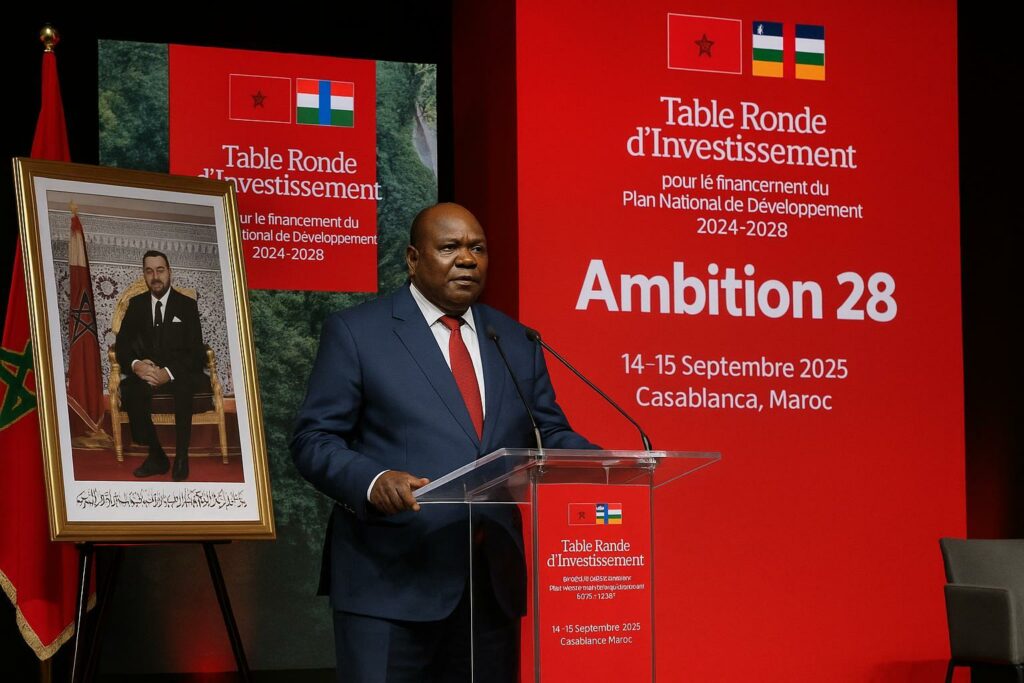Casablanca as the diplomatic-financial stage
By choosing Morocco’s economic capital for the 14-15 September 2025 Investment Round Table, President Faustin-Archange Touadéra signalled a deliberate pivot toward continental marketplaces able to lend both capital and credibility. He framed the venue as a tribute to “excellent historical relations” with Rabat and to King Mohammed VI’s pledge for shared prosperity, yet the decision also embeds Bangui within Casablanca Finance City’s fast-growing ecosystem, now home to more than two hundred twenty banks, insurers and funds active across Africa.
A $10.7 billion roadmap anchored in realism
Valued at roughly seven thousand billion CFA francs, the National Development Plan 2024-2028 seeks to transform a country too often reduced to conflict headlines into a laboratory for peace-through-growth. Moroccan Minister of Economy and Finance Nadia Fettah Alaoui underscored the political logic: “Every dollar invested represents a commitment to peace and sustainable development.” Her remark highlights Bangui’s calculation that capital markets respond more favourably to pragmatic budgets than to aspirational slogans.
Positioning amid Africa’s investment league table
The envelope places the Central African Republic in the medium range of current continental blueprints. Senegal’s third Priority Action Plan commands close to 41.4 billion dollars, Niger’s Renaissance III weighs 29.6 billion, while Gabon’s Transformation Acceleration Plan stands nearer 4.5 billion. By adopting a figure noticeably beneath Sahelian and West African neighbours, Bangui emphasises feasibility over grandeur, an approach consistent with its 2023 foreign direct investment inflow—under 30 million dollars according to UNCTAD.
Overcoming the foreign-investment gap
Within the Central African Economic and Monetary Community, the country lags behind peers: Cameroonian inflows reached an estimated 680 million dollars in 2023, Chad 780 million, and Congo 530 million, buoyed by hydrocarbons. The Casablanca gathering therefore aims to catalyse what economists term a ‘credibility premium’: visibility in a jurisdiction ranked first in Africa on the Global Financial Centres Index may reassure both bilateral and private investors that the programme will be executed within recognised governance norms.
South-South cooperation as strategic narrative
For Morocco, acting as host reaffirms its role as a continental springboard after channeling roughly 2.4 billion dollars of outward investment across Africa in 2024. For the Central African Republic, the symbolism is equally potent: rather than plead for traditional budgetary support in Paris, Brussels or Washington, Bangui showcases a willingness to leverage African platforms, resonating with the African Union’s Agenda 2063 discourse on endogenous solutions.
Assessing the momentum effect
Whether the round table converts pledges into disbursements will be scrutinised long after the last keynote speech in Casablanca. Investors are keenly aware of the security constraints that have historically inflated operating costs in the Central African Republic. Yet officials contend that bundling infrastructure, social cohesion and governance reforms inside a single costed matrix provides a measurable framework. The sequence—present plan, secure early-stage commitments, then seek multilateral guarantees—mirrors strategies that lifted Senegal and Côte d’Ivoire from fragile-state classifications over the past decade, albeit on smaller scales.
Economic lens: from promises to projects
Government advisers indicate that transport corridors, energy access and agro-industrial chains will absorb the bulk of spending, although detailed project sheets remain under confidentiality pending donor alignment. Development economists note that even partial mobilisation of the 10.7 billion dollar target would double Bangui’s capital formation rate, generating a multiplier effect on tax revenue and, by extension, security-sector financing. In that sense the plan is less a fiscal wish-list than a macroeconomic stabilisation instrument.
What Casablanca means for CEMAC
Locating the launch outside CEMAC territory may appear paradoxical, yet the choice underscores a collective regional challenge: deep, liquid capital markets remain scarce in Central Africa. Should Casablanca Finance City successfully intermediate resources toward Bangui, Yaoundé, Libreville and Brazzaville may replicate the model, reinforcing intra-African financial chains without undermining the BEAC monetary framework.

